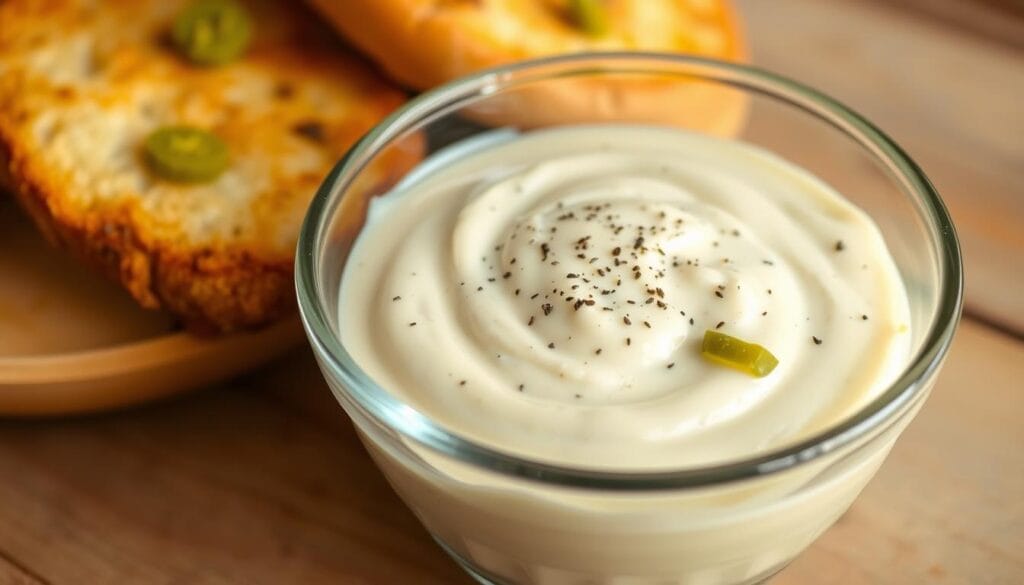The first time I had a crispy fish sandwich, it was amazing. The golden crust, tender fish, and tangy sauce changed my cooking view. Making the best fish sandwich is more than a recipe. It’s about creating a meal that makes you happy.
If you love seafood or want to improve your cooking, this guide is for you. You’ll learn how to pick the best fish and fry it perfectly. Soon, you’ll make a sandwich that rivals any restaurant’s.
Table of Contents
The History and Evolution of Fish Sandwiches
The fish sandwich has a long and interesting history. It has traveled from coastal areas to fast-food chains. This seafood sandwich has changed a lot over the years.
Origins of the Fish Sandwich
Fish sandwiches started as a simple meal for sailors and fishermen. They used bread and fish to make a tasty, easy-to-eat meal. This early version of the fish sandwich recipe was born from these practical needs.
- Coastal communities developed early seafood sandwich techniques
- Bread and fish became a convenient combination for workers
- Different regions developed unique preparation methods
McDonald’s Filet-O-Fish Revolution
In 1962, Lou Green introduced the Filet-O-Fish at McDonald’s. This was a big change, especially during Lent when people ate less meat. The Filet-O-Fish made seafood sandwiches popular in fast-food.
“The Filet-O-Fish transformed how Americans perceived fish sandwiches” – Culinary Historians
Modern Fish Sandwich Innovations
Today, fish sandwiches are more varied than ever. Gourmet places and fast-food chains offer many different kinds. They use different fish, special batters, and unique toppings.
- Panko-crusted fish fillets
- Artisanal bread selections
- Global flavor inspirations
Now, you can try everything from classic fast-food to fancy gourmet fish sandwiches.
Essential Ingredients for the Best Fish Sandwich
Creating the perfect fish sandwich starts with top-quality ingredients. Choose the right fish for great flavor and texture. Grouper and mahi-mahi are great choices because they’re firm yet flaky.
Fresh bread is key for a great fish sandwich. Pick hamburger buns or artisanal rolls that can handle the crispy fish. Toasting the bread adds flavor and keeps it from getting soggy.
Key Ingredients for Your Fish Sandwich
- Fresh fish fillets (cod, halibut, mahi-mahi)
- High-quality fresh bread
- All-purpose flour (½ cup)
- Cornmeal (¼ cup)
- Seasonings
- Oils for frying (canola, peanut, avocado)
For a crispy fish fillet, mix all-purpose flour and cornmeal for the coating. Fry at 350°F to 375°F for a golden-brown outside and a moist inside.
Essential Condiments and Toppings
- Tartar sauce (1 cup mayonnaise)
- Dijon mustard
- Fresh lemon juice
- Crisp lettuce or cabbage
- Sliced pickles
The FDA says to cook fish to 145°F for safety. With the right ingredients and care, your fish sandwich will be tasty and healthy.
Selecting the Perfect Fish for Your Sandwich
Creating a great fish sandwich begins with picking the right fish. Not all seafood is the same for making the perfect cod or salmon sandwich. Your choice can greatly affect the taste of your meal.
- Cod: A classic choice with firm white meat
- Haddock: Delicate flavor and smooth texture
- Pollock: Affordable and sustainable option
- Flounder: Rich in omega-3 fatty acids
- Mahi-mahi: Offers a slightly firmer texture
Fresh vs. Frozen Fish Considerations
Choosing between fresh and frozen fish is important. Fresh fish tastes better, but high-quality frozen fish is a good alternative. The trick is to thaw and handle it right.
Quality Indicators to Evaluate
Here are key signs of quality when buying fish for your sandwich:
- Clear, bright eyes (for whole fish)
- Firm, elastic flesh
- Fresh, mild ocean scent
- No discoloration or browning
- Minimal liquid in packaging
Pro tip: Culver’s North Atlantic Cod Sandwich and Popeyes Classic Flounder Fish Sandwich show how top-quality fish can turn a simple sandwich into a gourmet delight.
Creating the Ultimate Beer Batter
Making the perfect beer batter is key to a crispy fish fillet. It turns a simple fried fish sandwich into a work of art. The secret is using the right ingredients and techniques for a golden, crunchy outside.

Your beer batter recipe needs exact measurements for the perfect texture. Here’s what you need:
- Flour: 50 g
- Cornstarch: 100 g
- Light beer: 200 g
- Baking powder: 5 g
- Vinegar: 15 g
Flour and cornstarch make the ultimate coating. Cornstarch is the magic ingredient for extra crispiness. The beer adds flavor and makes the batter light and airy, sticking well to the fish.
| Ingredient | Purpose | Quantity |
|---|---|---|
| Flour | Base of batter | 50 g |
| Cornstarch | Creates crispiness | 100 g |
| Light Beer | Adds flavor and lightness | 200 g |
| Baking Powder | Helps batter rise | 5 g |
Here are some tips for a crispy fish fillet batter:
- Keep ingredients cold for maximum crispiness
- Whisk batter until just combined
- Let batter rest for 15 minutes before frying
- Maintain oil temperature at 350°F (176°C)
To make your fried fish sandwich, dip each fish chunk in the batter. Make sure it’s fully coated. You’ll get a crispy fish fillet that’s restaurant-quality and sure to wow.
Step-by-Step Guide to Making a Crispy Fish Fillet
To make a crispy fish fillet for your fried fish sandwich, you need precision and technique. The journey starts with careful preparation and understanding key cooking methods.
Preparation Techniques for Perfect Fish
Before starting, follow these essential steps:
- Pat the fish dry completely with paper towels
- Season the fish with salt and pepper
- Use a mix of cornmeal and flour for coating
- Dust fillets lightly with seasoned flour using a pastry brush
Mastering Frying Methods
Getting the perfect crispy fish fillet needs the right temperature and technique. Chefs suggest using a cast-iron skillet for even heat. The best frying temperature is between 385° to 400° Fahrenheit.
Creating the Perfect Golden Crust
The secret to a crispy fish fillet is in these steps:
- Keep oil temperature around 350°F
- Avoid overcrowding the pan
- Fry in small batches for 4-5 minutes
- Drain on paper towels to remove excess oil
Your goal is a crispy fish fillet with a golden-brown exterior. It should be light and crunchy, making your fried fish sandwich exceptional. The right technique turns simple fish into a culinary masterpiece.
Homemade Tartar Sauce and Condiments

Making the perfect tartar sauce can turn a simple fish burger into a work of art. Your homemade sauce adds fresh, lively flavors that beat store-bought options any day.
The classic tartar sauce recipe is easy to make. With a few basic ingredients, you can create a sauce that pairs well with your fish sandwich:
- 1/2 cup mayonnaise
- 3 tablespoons chopped dill pickles
- 1 tablespoon fresh lemon juice
- 1 teaspoon fresh dill or parsley
- Optional: 1/2 teaspoon Dijon mustard
Here are some tips for making your tartar sauce:
- Chop pickles finely for a smooth texture
- Use fresh lemon juice for brightness
- Adjust seasonings to your taste preference
“The secret to an amazing tartar sauce is fresh ingredients and a balance of tangy and creamy flavors.” – Professional Chef
The nutrition facts for this homemade tartar sauce are great. Each tablespoon has about 64 calories, 6.9 grams of fat, and almost no carbs. The sauce stays good for up to a week in the fridge, making it great for many fish sandwiches.
Pro tip for your tasty fish burger: Make your tartar sauce at least 30 minutes before serving. This lets the flavors mix well, making your sandwich taste even better.
Bread Selection and Preparation Tips
Making the perfect seafood sandwich begins with picking the right fresh bread. The right bread can turn a simple fish sandwich into something amazing. It’s all about finding the perfect match for the fish’s flavors.
- Brioche buns: Rich and buttery texture
- Ciabatta: Crusty outside, soft inside
- Potato rolls: Soft and a bit sweet
- Sourdough: Tangy taste that goes well with fish
Toasting Techniques for Perfect Bread
Toasting your bread is key for a great seafood sandwich. Here’s how to toast it perfectly:
- Preheat a skillet to medium heat
- Butter both sides of the bread lightly
- Toast for 1-2 minutes until it’s golden
- Make sure it’s crispy on the outside but soft inside
Assembly Tips for Maximum Flavor
Building a great seafood sandwich is more than just picking fresh bread. Pro tip: Toast your buns until they’re a bit crispy to avoid sogginess. Add a thin layer of butter or mayo to keep the bread and fish separate. This keeps your sandwich crisp and tasty from start to finish.
For the best seafood sandwich, pick bread that matches your fish without hiding its taste. Whether you like soft brioche or crusty ciabatta, the right bread makes your sandwich unforgettable.
Creative Toppings and Variations
Turn your fish burger into a masterpiece with exciting toppings. Your seafood sandwich can be more than just a meal. It can be a journey of flavors!
Here are some creative topping ideas to make your seafood sandwich unique:
- Spicy Options:
- Chili crisp for a bold kick
- Candied jalapeños (cowboy candy)
- Wasabi mayo for heat lovers
- Global Flavor Inspirations:
- Kimchi for a tangy Korean twist
- Yuzu kosho for a citrusy punch
- Giardiniera for an Italian-style crunch
- Unique Condiment Combinations:
- Cream cheese and capers
- Chamoy sauce for a Mexican flair
- Major Grey’s chutney for sweet complexity
Fresh toppings can change your fish sandwich. Try adding sliced avocado, pickled veggies, or tropical fruit salsa. These can add a new twist beyond lettuce and tomato.
“A great sandwich is all about balance and unexpected combinations” – Culinary Experts
For a fantastic fish burger, experiment with textures and flavors. Don’t hesitate to mix and match toppings that thrill your taste buds!
Tips for Serving and Storage
Creating the perfect fish sandwich recipe is not just about cooking. It also involves smart serving and storage. Your fish sandwich tastes best when you eat it right after cooking. This way, it stays crispy and flavorful.
If you need to keep the sandwich warm, use a low-temperature oven. Set it between 180° to 200°F for up to 15 minutes. This keeps the sandwich warm without losing its quality.
When storing ingredients, keep them separate. Raw fish and prepared ingredients can stay in the fridge for up to 3 days. To reheat leftover fish, preheat your oven to 375°F. Warm the fillet for 5-7 minutes to keep it crispy.
Always handle seafood safely. Let cooked fish cool to room temperature before refrigerating. When reheating, make sure the fish reaches 145°F. This ensures it’s safe to eat.
Wrapping sandwich components separately is a good tip. It helps prevent the bread from getting soggy. This way, you can make a fresh-tasting fish sandwich whenever you want.
Proper storage and reheating are key to keeping your fish sandwich delicious. By following these tips, every bite will be as tasty as the first. Your effort will be well worth it.

